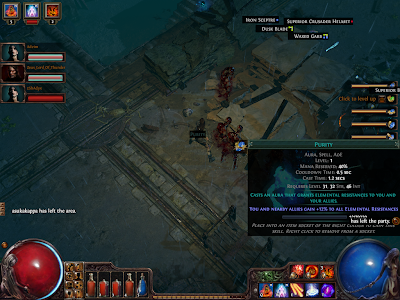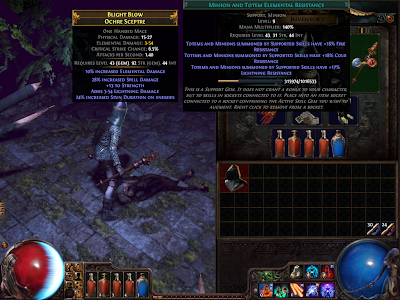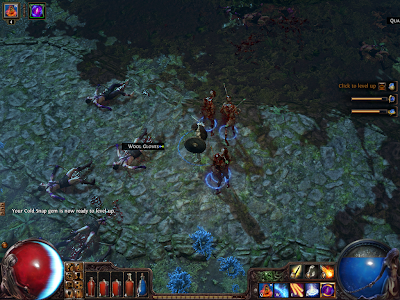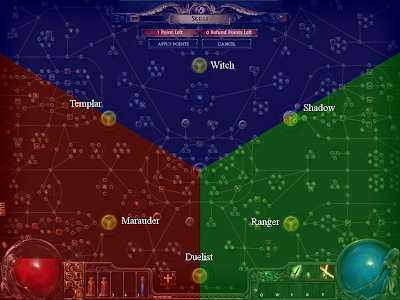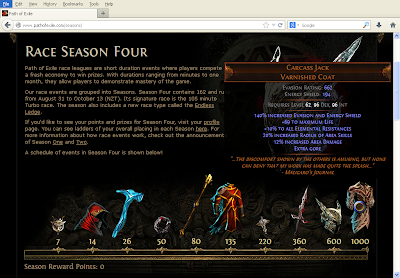Although there are quite a few items and equipment types in Path of Exile, they no doubt still adhere to regular MMO convention - i.e. Needs to be at a certain level or have certain amount of Strength, Dexterity and/or Intelligence to equip/use it.
Furthermore, since their usage are pretty much a no-brainer (or can be easily derived from their item descriptions), I am therefore instead going to skip all of those introductions and just straightaway focus on the more subtle, critical aspects.
Item Rarity and Modifiers
Pretty much just about everything that you can see and find in this game can come in four varying rarities, Normal, Magic, Rare and Unique.
| Normal | Magic |
 |  |
| Rare | Unique |
 |  |
- Normal
Normal rarity items are simply just basic items with no modifiers found on them. However, the redeeming feature about them is that you can use a variety of easily obtainable "tool items" to transform them into the other rarities without changing the "core" of the item (i.e. A Quartz Sceptre will remain as a Quartz Sceptre).
Orb of Transmutation - Upgrades a normal item into a magic item.
Orb of Alchemy - Upgrades a normal item into a rare item.
Orb of Chance - Upgrades a normal item into a random rarity.
- Magic
Magic rarity items are simply just one step up from being a normal item. They can hold up to two modifiers.
Orb of Augmentation - Enchants a magic item with a new random property. (One new modifier will be added so long as it has the space.)
Orb of Alteration - Reforges a magic item with new random properties. (The modifiers on that item will be rerolled.)
Regal Orb - Upgrades a magic item into a rare item. (It will retain its current modifiers and one new modifier will be added.)
- Rare
More or less functioning in the same way as magic rarity items, the only difference is that rare items can hold up to six modifiers in total.
Exalted Orb - Enchants a rare item with a new random property. (One new modifier will be added so long as it has the space.)
- Unique
Contrary to how normal, magic and rare items work, unique items are considered the most "rigid" of them all. They have specific names, unique artwork and a fixed list of modifiers which cannot be altered, only tweaked...and only for modifiers that are actually coded with a flexible range.
Example:
Path of Exile - Item Modifiers
Path of Exile - List of Unique Items
Just like skill gems, most of the items and equipments found in the game also has a quality factor appended to it. And likewise, the stats that do get affected by the quality factor also differs depending upon the item in question.
For example, weapons would typically have their weapon damage improved by the quality factor while armors would have their defensive stats improved instead. Life and Mana flasks would have the amount of HP or MP they replenish increased by the quality, while on the other hand, utility flasks that offers a temporary buff would have their durations improved by the quality factor.
However, that is not my purpose of mentioning about quality here because those can be easily identified and picked up by you when you start playing the game. And so the actual purpose of this section is to highlight (to you) the various "tool items" that you may obtain and use, to help raise the quality factor of any particularly good item that you may happen to have gotten.
| Item | Tool Item | Additional Info |
| Armor Parts | Armourer's Scrap | Improves the Quality by: - 5% for Normal items - 2% for Magic items - 1% for Rare and Unique items Maximum quality is capped at +20% (just like skill gems) |
| Weapons | Blacksmith's Whetstone | |
| Flasks | Glassblower's Bauble | |
| Maps | Cartographer's Chisel |
Sockets
As I have already mentioned about the uses of sockets and their relationship to skill gems in an earlier part, hence this segment isn't to repeat what we've already touched upon. Instead, what we're going to focus on is actually the "tool items" that we can use to modify these sockets (on equipments) and roughly how they work...which is why this segment is found as a subsection under "Items and Equipments".
Basically, there are a total of three such "tool items", that we must get acquainted with, that has something to do with sockets. They are namely, the "Jeweller's Orb", the "Orb of Fusing" and the "Chromatic Orb".
- Jeweller's Orb
This orb's function is to re-roll the number of sockets on an item (weapon or a piece of armor). And like its description states, if the item has any quality value found on it, it will be consumed to increase your chances of getting more sockets.
However, you must realize that there is a maximum limit to the number of sockets that can be found on an item. Furthermore, it is dictated, by the system, that this limit is affected by both the "type" of the item as well as its intrinsic "item level"...with the "type" being the dominant factor (i.e. Number of sockets cannot exceed "type" limit regardless of its "item level").
Number of Sockets Up to 3 Up to 4 Up to 6 Item Type One-handed Weapons
ShieldsHelmets
Gloves
BootsTwo-handed Weapons
Chest
Number of Sockets Up to 2 Up to 3 Up to 4 Up to 5 Up to 6 Minimum Item Level 1 15 28 35 50
* The color of the sockets obtained is determined randomly and follows the same set of rules as when using a "Chromatic Orb".
* The links between the sockets obtained is determined randomly and follows the same set of rules as when using an "Orb of Fusing".
* Exceptions:
Starting Weapons (has 3 sockets of three different colors even though they are level 1)
Tabula Rasa (has 6-linked white sockets which can fit any colored skill gem)
- Orb of Fusing
This orb's purpose is to re-roll the links between the sockets on an item. And like its description states, if the item has any quality value found on it, it will be consumed to increase your chances of getting more links.
However, once again, you will have to note that the formation of these links aren't random and actually follows a predetermined pattern of linking like as shown below.
Now if you take a look at the 6-socket item at the top left corner, it is actually a chest armor comprising of two 3-linked sockets even though it has 4 out of 5 of its links activated.
Just because the link at position 3 had failed to be activated, this item actually falls short of becoming a 6-linked host item for powerful skill gem combos. And even before that, if only one of the links from either position 1 or 5 had moved to position 3 instead, then this item could have been a potential host for a decent 5-linked skill gem combo...so can you now appreciate how important the links and their positions are?
Anyway, as far as I have heard, the chances of activating any of the 5 links isn't merely a simple 50-50 probability. It actually depends upon whether the adjoining links are active or not. If they are, then the chance of activating this particular link would be correspondingly lowered. (I'm not sure by how much though...)
What's more, every time you use an Orb of Fusing on the item, activated links will not be preserved. All of them will be re-rolled all over again so it is actually that much harder to activate all of the links than you may think.
- Chromatic Orb
Now this orb's function is to re-roll the color of the sockets found on an item. And much like when using an Orb of Fusing, none of the sockets' colors will be preserved during the re-roll.
But perhaps as a source of comfort, it is interesting to note that although the choice of color you may get for a socket is random, their probabilities (of getting a red, green or blue socket) aren't equal. In fact, they are actually highly dependent upon the attributes which the player needs in order to use that item.
For example, if that item requires the "Strength" attribute to use, the chances of obtaining a red socket is said to be at around 90% while obtaining a green or blue socket would be at around the leftover 10% (5% green, 5% blue perhaps?). Likewise, if it required "Dexterity" or "Intelligence" instead, then the 90% chance would be for a green socket and a blue socket respectively.
If however the item has two attribute requirements, then the 90% chance would be split between the two attributes' representative colors equally and the last 10% would be for the remaining color (i.e. 45%, 45%, 10%).
| Previous: Path of Exile (Part Four) | Next: Path of Exile (Part Six) |







 Thursday, October 24, 2013
7:24 PM
Thursday, October 24, 2013
7:24 PM
 BuLaDiFu
BuLaDiFu

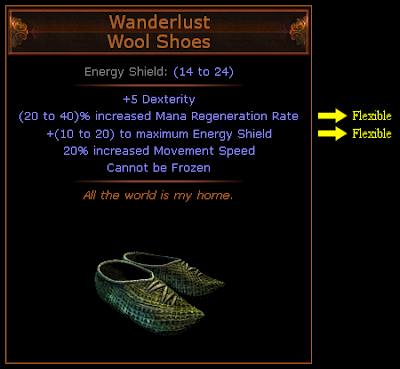




 Posted in:
Posted in: 

